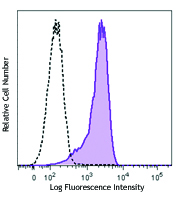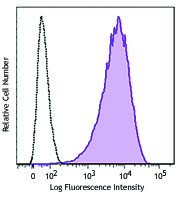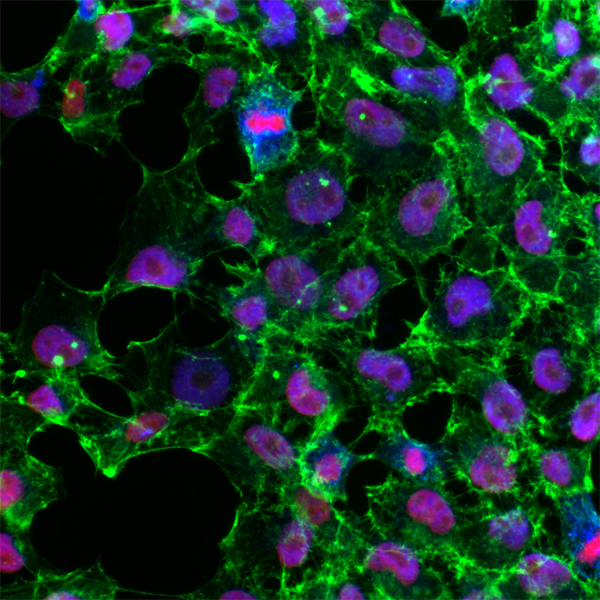- Clone
- 14A6A34 (See other available formats)
- Regulatory Status
- RUO
- Other Names
- SRY-related HMG-box gene 2, SRY (sex determining region Y)-box 2, MCOPS3, ANOP3
- Isotype
- Mouse IgG1, κ
- Ave. Rating
- Submit a Review
- Product Citations
- publications

-

Human embryonic carcinoma NCCIT cells were fixed and permeabilized with FOXP3 Fix/Perm Buffer Set, and then stained with SOX2 (clone 14A6A34) (filled histogram) PE or mouse IgG1, κ PE isotype control (open histogram).
| Cat # | Size | Price | Quantity Check Availability | Save | ||
|---|---|---|---|---|---|---|
| 656103 | 25 tests | $153 | ||||
| 656104 | 100 tests | $360 | ||||
SOX2 is the most studied member of SRY-related box transcription factor family. It binds to target genes through its highly conserved HMG box domain. Inactivation of the SOX2 gene causes lethality during embryonic development. SOX2 knockdown in embryonic stem cells results in their differentiation. Co-expression of SOX with OCT4, MYC, and KLF4 is sufficient to reprogram somatic cells to induced pluripotent stem cells (iPSCs), which exert similar characteristics as natural pluripotent stem cells. These findings indicate that SOX2 is crucial for the self-renewal and pluripotency of embryonic stem cells. In addition, over-expression of SOX2 has been found in various types of malignant cancer. Knockdown of SOX2 results in cell cycle arrest by downregulating cyclin D1 and inhibition of tumor cell proliferation, suggesting that SOX2 is involved in activating genes associated with tumor progression.
Product DetailsProduct Details
- Verified Reactivity
- Human, Mouse
- Antibody Type
- Monoclonal
- Host Species
- Mouse
- Immunogen
- Full length human SOX recombinant protein
- Formulation
- Phosphate-buffered solution, pH 7.2, containing 0.09% sodium azide and BSA (origin USA)
- Preparation
- The antibody was purified by affinity chromatography and conjugated with PE under optimal conditions.
- Concentration
- Lot-specific (to obtain lot-specific concentration and expiration, please enter the lot number in our Certificate of Analysis online tool.)
- Storage & Handling
- The antibody solution should be stored undiluted between 2°C and 8°C, and protected from prolonged exposure to light. Do not freeze.
- Application
-
ICFC - Quality tested
- Recommended Usage
-
Each lot of this antibody is quality control tested by intracellular immunofluorescent staining with flow cytometric analysis. For flow cytometric staining, the suggested use of this reagent is 5 µl per million cells in 100 µl staining volume or 5 µl per 100 µl of whole blood.
- Excitation Laser
-
Blue Laser (488 nm)
Green Laser (532 nm)/Yellow-Green Laser (561 nm)
- Application Notes
-
This clone is not recommended for ChIP (Chromatin Immunoprecipitation) assays (as determined by in-house testing).
- Product Citations
-
- RRID
-
AB_2562852 (BioLegend Cat. No. 656103)
AB_2562853 (BioLegend Cat. No. 656104)
Antigen Details
- Structure
- 317 amino acids, predicted molecular weight of 34 kD, contains a HMG box domain responsible for DNA binding
- Distribution
-
Nucleus
- Function
- Transcription factor that regulates the expression of the genes involved in embryonic development
- Interaction
- Interacts with FGFR1, SOX3, and ZSCAN10
- Cell Type
- Embryonic Stem Cells, Mesenchymal Stem Cells, Neural Stem Cells
- Biology Area
- Cell Biology, Cell Cycle/DNA Replication, Immunology, Neuroscience, Neuroscience Cell Markers, Stem Cells, Transcription Factors
- Antigen References
-
1. Rizzino A. 2009. Wiley Interdiscip. Rev. Syst. Biol. Med. 1:228.
2. Stolzenburg S, et al. 2012. Nucleic Acids Res. 40:6725.
3. Lai YS, et al. 2012. Proc. Natl. Acad. Sci. USA. 109:3772.
4. Jeong CH, et al. 2010. Stem Cells 28:2141.
5. Xiang R, et al. 2011. Br. J. Cancer 104:1410.
6. Card DA, et al. 2008. Mol. Cell Biol. 28:6426. - Gene ID
- 6657 View all products for this Gene ID
- UniProt
- View information about SOX2 on UniProt.org
Related FAQs
- What type of PE do you use in your conjugates?
- We use R-PE in our conjugates.
Other Formats
View All SOX2 Reagents Request Custom Conjugation| Description | Clone | Applications |
|---|---|---|
| Purified anti-SOX2 | 14A6A34 | WB,ICC |
| PE anti-SOX2 | 14A6A34 | ICFC |
| Alexa Fluor® 594 anti-SOX2 | 14A6A34 | ICC |
| Alexa Fluor® 488 anti-SOX2 | 14A6A34 | ICFC,ICC |
| Alexa Fluor® 647 anti-SOX2 | 14A6A34 | ICC,FC |
| Pacific Blue™ anti-SOX2 | 14A6A34 | ICFC |
| Brilliant Violet 421™ anti-SOX2 | 14A6A34 | ICC |
| TotalSeq™-B1224 anti-SOX2 Antibody | 14A6A34 | ICPG |
Customers Also Purchased


Compare Data Across All Formats
This data display is provided for general comparisons between formats.
Your actual data may vary due to variations in samples, target cells, instruments and their settings, staining conditions, and other factors.
If you need assistance with selecting the best format contact our expert technical support team.
-
Purified anti-SOX2
Total cell lysate from NTERA-2 cells (lane 1, 15 µg), NF-1 c... 
NTERA-2 cells were fixed with 4% paraformaldehyde (PFA) for ... 
Total lysates (15 µg protein) from HeLa (Low expression nega... -
PE anti-SOX2

Human embryonic carcinoma NCCIT cells were fixed an... -
Alexa Fluor® 594 anti-SOX2

NCCIT cells were fixed with 1% paraformaldehyde (PFA) for 10... -
Alexa Fluor® 488 anti-SOX2

Human embryonic carcinoma NCCIT cells were fixed an... 
NCCIT cells were fixed with 1% paraformaldehyde (PF... -
Alexa Fluor® 647 anti-SOX2

Human embryonic carcinoma NCCIT cells were fixed and permeab... 
NCCIT cells were fixed with 1% paraformaldehyde (PFA) for 10... -
Pacific Blue™ anti-SOX2

Human embryonic carcinoma NCCIT cells were fixed an... -
Brilliant Violet 421™ anti-SOX2

NCCIT cells were fixed with 1% paraformaldehyde (PFA) for te... -
TotalSeq™-B1224 anti-SOX2 Antibody
 Login/Register
Login/Register 















Follow Us